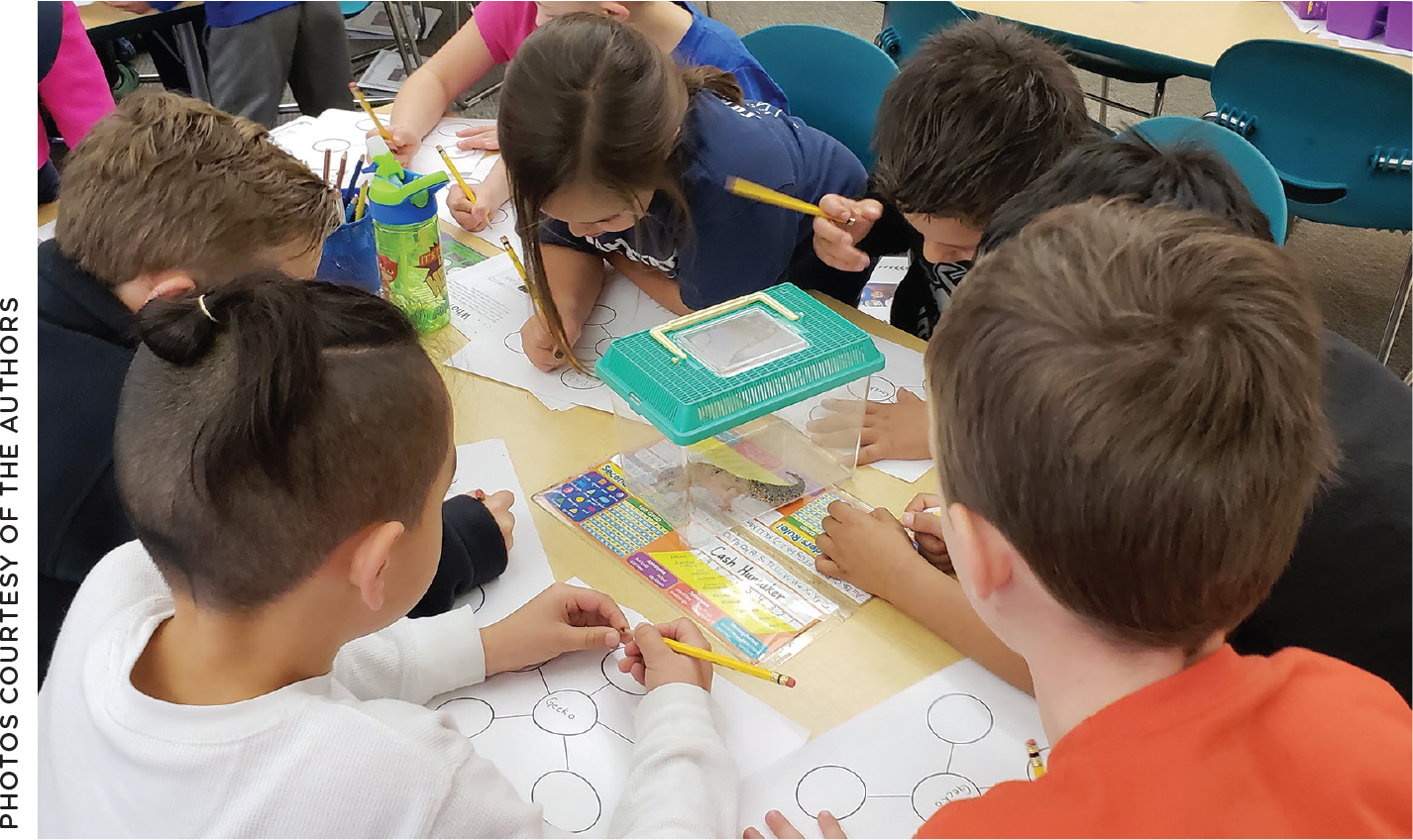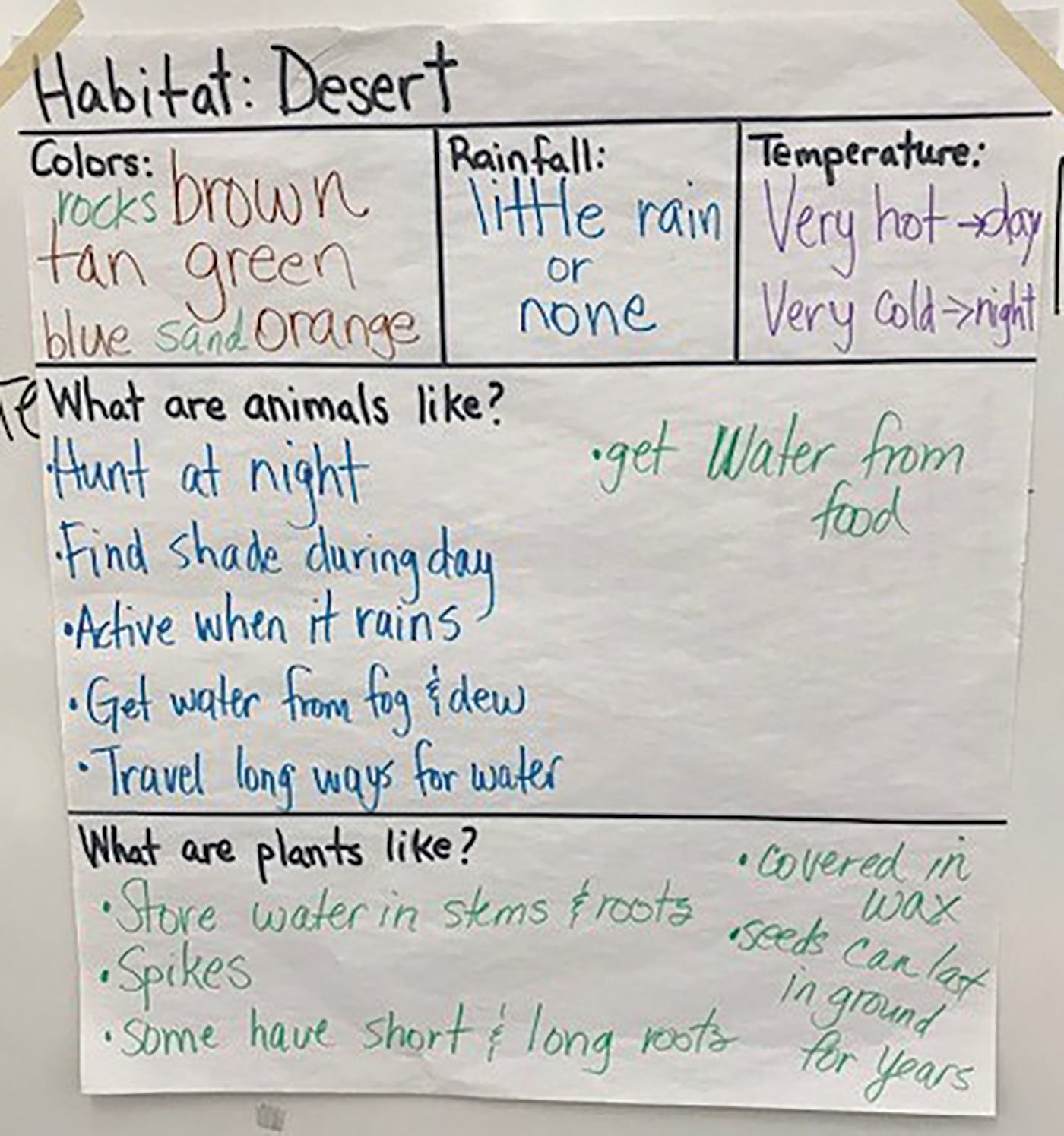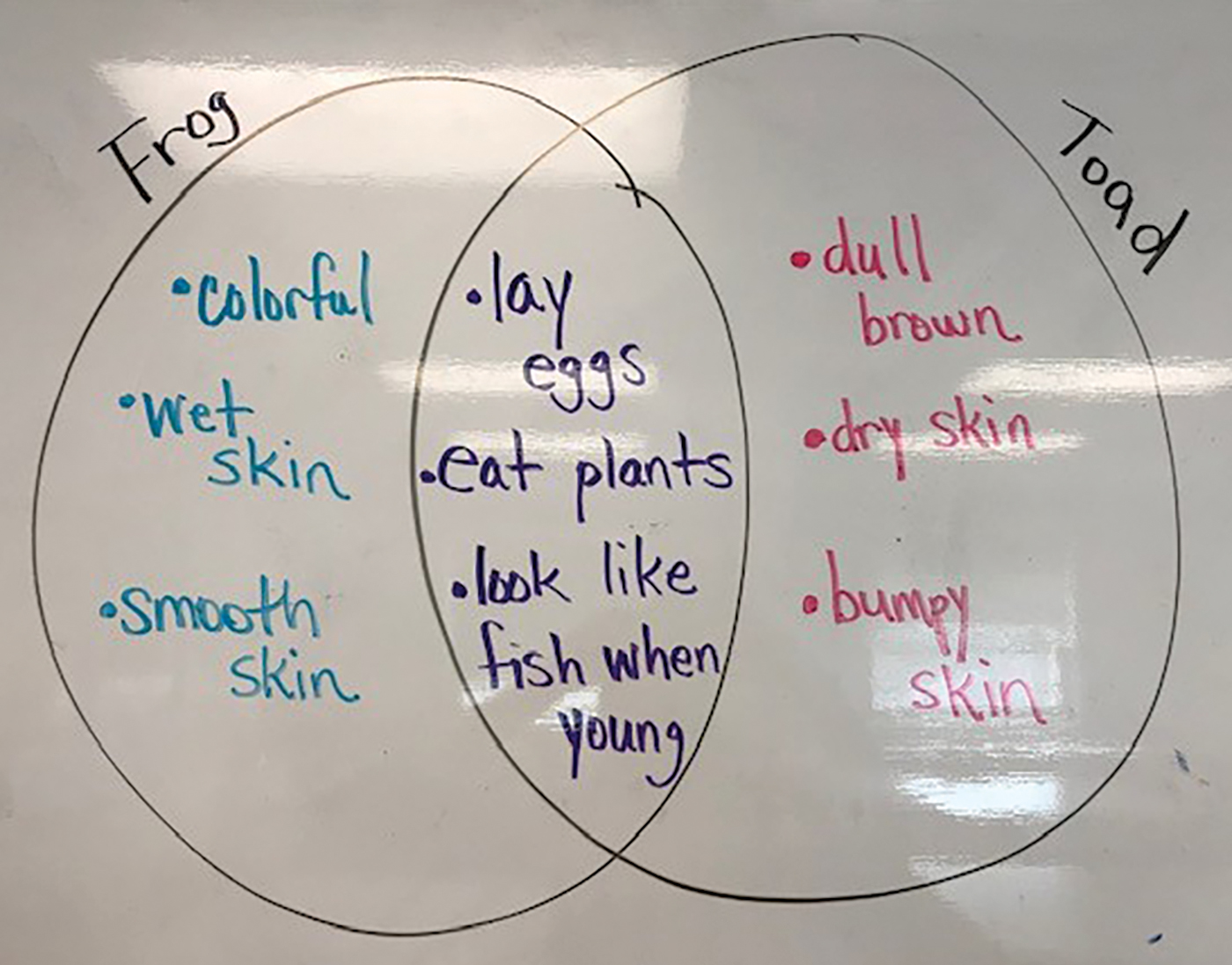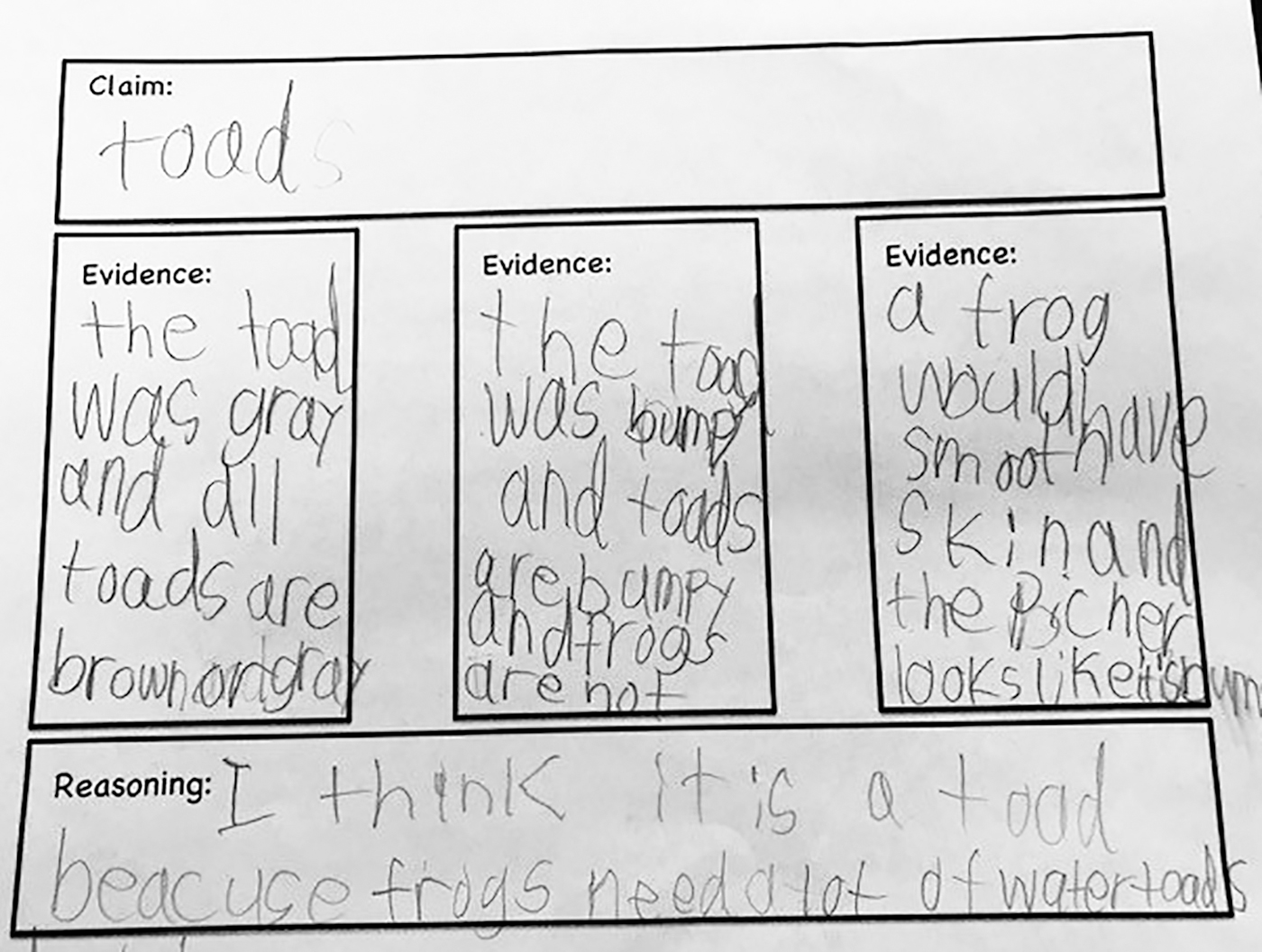Cross-curricular Connections
Science in the Literacy Block
A model for early elementary integrated instruction
Science and Children—November/December 2020 (Volume 58, Issue 2)
By Kimberly Lott and Sarah Clark
Quick Tips for Distance Learning
For teachers:
Be sure to include a way to actively engage with science content and not just through the use of reading, writing, and speaking about a science topic. Consider the types of communication that scientists engage in with each other as they learn new ideas and concepts.
Remember that a student’s attention span is the same as their age plus or minus two minutes. This means if a child is six-years-old, his or her attention span will be approximately four minutes to eight minutes. Be sure to break down the learning into smaller learning segments or chunks that fit the attention span of your students. Do not expect children to sit through a long lesson, especially during online learning. Learning segments might include reading a book about a science topic for eight minutes, followed by a discussion as a class about what was read, and concluding with a six-minute segment where students go outside to locate an object in the outdoors related to the science topic.
For parents:
Encourage your child to ask questions. This is the joy of studying science! It is not your job as the parent to answer all of these questions on your own. Take the time to explore your child’s questions and show an interest in what they want to learn. You can locate answers in myriad ways, including observations in the outdoors, reading books on the topic, and by exploring the internet and watching videos available online. Don’t forget to ask your own questions to show your child that no matter the age, we are all still learning.
When your child comes across a word they don’t know, you have two options. First, you can give them a sound that they need to read the word correctly, or you can simply say the word aloud if it is a difficult word to read.
Early elementary teachers play an essential role in fostering students’ foundational knowledge, skills, and attitudes. In the early elementary grades, students develop fundamental understandings of the natural world that can set them on learning and attitudinal trajectories toward future engagement with science, technology, engineering, and mathematics (STEM) (Eshach and Fried 2005; Lind 1999; Osborne and Dillon 2008). Yet, despite this importance, “science time” in many early elementary classrooms is minimal compared to the time spent on literacy and math (Trygstad et al. 2013).
While early elementary teachers may be heavily focused on teaching core curricula (especially reading and writing literacy skills), science activities can be incorporated into the regular school day to provide the context though which other skills can be taught. Science content is engaging for young curious minds and often increases the motivation for learning core curriculum and literacy skills, all while developing science content knowledge. The practices of science and the core literacies (reading and writing) are clearly related (see Table 1) and can be mutually beneficial to both subjects (Goldschmidt and Jung 2011).
| Table 1. Alignment of NGSS practices with CCSS for English Language Arts. | ||||||||
|---|---|---|---|---|---|---|---|---|
|
Integrated science instruction is often overwhelming for teachers because they are trying to fit the core literacy practices into science. In other words, they are considering their already limited time for science and trying to envision putting more into it. Instead, teachers should ask, how does science fit into my literacy instruction? Since there are already allocated times for reading comprehension and writing during every school day, science can become the context for learning these literacy skills.
By using literacy techniques that increase students’ reading comprehension and writing abilities, students can increase their science content knowledge and be able to demonstrate this knowledge in their writings. To increase students’ reading comprehension, literacy experts suggest that teachers use close reading techniques where teachers read literary text while focusing the listener on key features of the text or particular content the author is trying to convey. These close reading techniques can also be used to help students develop their writing skills. The “Read to Write Model” is a technique where the teacher uses the literacy text as a model of a particular writing genre and then students use this model to write in this genre (see Clark, Jones, and Reutzel 2013).
For example, the second-grade Common Core Language Arts standards include students being able to participate in shared research and write informational texts in which they introduce a topic, provide facts and details, and provide a concluding statement (NGAC and CCSSO 2010). This standard aligns with the Next Generation Science Standards (NGSS) science practices of Constructing Explanations and Engaging in Argument With Evidence. When students construct scientific explanations, we want them to make their claims based on evidence and reasoning. Using a Claims, Evidence, and Reasoning chart, students make claims about phenomena and support their claims with evidence and reasoning gathered during investigations or from informational text. They can use this organizer to then write a scientific explanation where their claim is the topic sentence, their evidence supplies the supporting details, and their reasoning provides the concluding statement.

Students record observations of some class visitors.
This article outlines a two-week daily integrated unit on biodiversity for second grade using the read to write model along with close reading techniques to improve student comprehension of compare/contrast text structure and science explanatory writing. This unit is aligned to the second-grade science standard 2-LS4-1, Make observations of plants and animals to compare the diversity of life in different habitats (NGSS Lead States 2013). To understand biodiversity, students need to be able to notice the differences and similarities of plants and animals within and between habitats. For this reason, we chose compare and contrast as a text structure appropriate for this unit. Through comparing and contrasting informational texts, students can not only gather information about different types of animals or plants but also use these as a model to write about what they have learned. And last, throughout the unit students practice scientific explanatory writing by making claims supported by evidence and reasoning.
Engage
On the first day of the unit, the teacher asked, “What is a scientist?” “A person who tests stuff to make sure it is safe for people,” was a student reply. The teacher explained that scientists do indeed “test stuff” but also need to be able to communicate what they have learned to others, and one way is through writing scientific explanations. “A good scientist is also a good writer,” the teacher tells the students.
Each student was then given an animal card—simply a piece of paper with an animal picture printed on it (see NSTA Connection). Around the room, the teacher placed anchor charts with the titles Desert, Forest, Ocean, and Polar Region. Referring to the four habitat charts, the students were asked to think about what habitat their animal might live in and write an explanation in their science journal of how they knew their animal lived in that particular habitat. After writing their explanation, the students attached their animal card to the anchor chart of the habitat where they thought the animal lived.
Referring to the anchor charts, the teacher then asked the guiding questions, “What do you notice about the animals that live in the ocean? Forest? Desert? and Polar Regions? How are they different? Do they share similar characteristics?” Students noted that animals look different within and between each habitat, but animals in the same habitat have similar characteristics. “All the desert animals look dry,” one student commented, with another adding, “there is snow in the polar region, so animals there have thick fur.”
Exploring Different Habitats
The exploration of different habitats through literacy text was completed during the reading comprehension time of the literacy block. The teacher explained that scientists often read books to gather information about the topics they are studying. Like scientists, students gathered information from the text and recorded their findings in both writing and science journals.
Description of the Habitat
In order to give an overall background of deserts, the teacher read About Habitats: Deserts by Cathryn Sill (2012) and told the students to listen for information that might be useful to describe this habitat. After reading the book, the teacher presented an anchor chart with headings (temperature, rainfall, types of animals, types of plants, etc.) and recorded information the students gathered onto the chart (Figure 1). The teacher read the text again, asking, “Is there anything else we need to add to our chart?” and then added additional information given by the students to the chart.

Example of a habitat anchor chart.
Animal Compare/Contrast
The teacher then introduced the book Frog or Toad? by Susan Kralovansky (2014). She referred to the table of contents and students made predictions on what they think the book will be about. During the first read, students gathered information about frogs and toads. After the first read, the students discussed with a partner how these two animals are alike and different. After small-group talk, the students shared as a whole class. The teacher recorded the similarities and differences in a Venn diagram (Figure 2). The teacher then read the text again, but this time as she is reading, she referred to signal words the author uses to compare the animals (both, similar, like, but, and so on). Students then created a Venn Diagram in their writing journals adding linking words where appropriate.

Example of a Venn diagram for comparison.
Scientific Explanations
Before writing scientific explanations, the teacher asked the students, “What is an opinion?” “It is just whatever you think,” answered a student. The teacher then asked for each student to think in their mind about their favorite food and then one student was asked to share, “My favorite food is cereal.” The teacher then asked, “Why do you like cereal?” The student listed several reasons that she liked cereal. The teacher then explained that writing explanations in science is similar to writing about opinions, “You have reasons to support your opinions and in science you have evidence.” The teacher explained that evidence is not just “what you think” but is observable and there is scientific reasoning to support it.
With students gathered at the reading rug, the teacher returned to About Habitats: Deserts by Cathryn Sill. On Plate 9 in this book, there is a picture of the New Mexico spadefoot toad. [Note: Even though the plate is labeled in small print, the text read to the students does not explicitly state that it is a toad.] Referring to this picture, the teacher asked, “Do you think that is a frog or toad?” The students overwhelmingly said, “toad.” The teacher explained that they had just made what is called a claim or an answer to a question in science. The teacher then introduced the Claims, Evidence, Reasoning (CER) chart. She explained that this was a tool to organize their scientific explanations. Using the CER chart, students began to fill in their claim, evidence, and reasoning from their observations of the picture and their reading for which animal, frog or toad, would be better suited to live in the desert.
At first, students struggled with the scientific reasoning. It was easy for them to make claims and then list evidence based on the picture or informational text, but there were many hands up when it came time for writing their reasoning. For example, a student had written “toad” as his claim, “then dry skin, bumpy skin, and brown color” as evidence, but had left the reasoning blank. The teacher asked that student, “Why would dry, bumpy, and brown skin help a toad live in a desert?” The student replied, “I don’t know, maybe it would blend in?” “Yes,” the teacher reassured him, “that is your scientific reasoning.”
The teacher then explained to all the students that the scientific reasoning was the “because statement” that comes after they make their claims. To illustrate this, the teacher asked again (referring to the picture in About Habitats: Deserts), “Do you think that is a frog or a toad living in that desert?” One student replied, “It’s a toad because the desert is dry and toads do not need much water.” The teacher wrote this sentence on the board and pointed out that “It’s a toad” was the claim and “the desert is dry and toads do not need much water” is the scientific reasoning. The teacher reminded the students that scientific reasoning must be based on ‘science’ and not just “what you think,” so in this case the students had to refer back to their anchor chart on deserts and what characteristics animals living in the desert share.
The students then went back to their CER charts and added their scientific reasoning if it was missing. The teacher also reminded the students that the evidence must support or “back up” the scientific reasoning. In the beginning, many students had filled in evidence in their charts but had just listed unrelated facts from the informational text. The teacher noticed that once students had a better understanding of scientific reasoning, their evidence became accurate observations that supported the claim and reasoning (see Figure 3).

Example of a Claims Evidence and Reasoning chart.
This cycle of habitat description, animal compare/contrast, and scientific explanations was repeated for each habitat in the biodiversity unit. All compare/contrast Venn diagrams were completed in their writing journals, and CER charts were compiled in their science folders. As the unit progressed, the students became more comfortable with the Venn diagrams and especially the CER charts, requiring minimal guidance by the end.
Table 2 summarizes the books used for each habitat and the prompts used for scientific explanations. All books in this unit were found using Get Epic (https://www.getepic.com), a free online resource for literacy materials. Books on the website are cataloged by appropriate age, duration of read, AR Level, and Lexile Measure, so all books selected for this unit were appropriate for the age and average reading level of the students. Books were read either as a whole class using a projector or in student pairs using chrome books. Student pairings were intentional in that struggling readers were placed with more skilled readers who could assist with the reading as needed.
| Table 2. Books and writing prompts for habitat study. | ||||||||||||||||||||
|---|---|---|---|---|---|---|---|---|---|---|---|---|---|---|---|---|---|---|---|---|
|
Elaborations
Elaborations were done during the science time of the day. Students took a walking field trip outside their school. While on the walk, the teacher had students notice the different types of micro habitats found around the school, like a shady spot under a tree, a dry field on the playground, or a low spot where water collects. Working in groups of four with iPads, student took pictures of any plants or animals (including insects) that they noticed living in these habitats. After returning to the classroom, the teacher recorded on anchor charts the different micro-habitats observed and the plants and animals found in each.
Evaluation
The evaluation of this unit was two-fold. First, we wanted to see if see if students compare/contrast writing improved after an integrated science unit. Before the unit began, students were asked to write a compare/contrast informational text on summer and winter. After the unit, the students picked one of the Venn diagrams they made of animal comparisons during the unit and wrote a compare/contrast informational text of those two animals. Student writing was evaluated using the compare/contrast writing rubric (see NSTA Connection).
Second, we wanted to see the progression of students’ scientific explanations from beginning to end of the unit. At the beginning of the unit, we asked students to write an explanation for why they sorted animals into particular habitats. Student explanations prior to the unit were short, usually only stating one piece of evidence to support their claim. Several of students noted in their explanations that animals lived in a particular habitat because they liked it. “Polar bears live in the polar regions because they like the cold” or “Monkeys live in the forest because they like hanging from trees.”
At the end of the unit, the teacher read Can you tell the difference b/w a gecko and a salamander? by Buffy Silverman (2012). Using this text and observations of gecko and salamander class pets, students were asked to write an explanatory text for which animal, gecko or salamander, could live in the desert. Students’ science explanations were much longer after the unit. Students listed multiple evidences for their claims and included scientific reasonings instead of animal feelings. Student writing was evaluated using the claims, evidence, and reasoning rubric (see NSTA Connection).
Conclusion
Integrating science and literacy instruction is a beneficial to both subjects. In the area of literacy, students are provided with meaningful content in which to practice their reading and writing skills. Students read books on the science topic, study data collected, write notes in science journals, organize information in graphic organizers (e.g. Venn diagram, CER charts), and demonstrated learning by writing informational text demonstrating their knowledge of science content and how to write informational text effectively. By combining the science time with the literacy block, students have more time for deeper investigation and more authentic science writing experiences.
Resources
Kralovansky, S. 2014. Frog or toad? North Mankato: Abdo Publishing.
Sill, C. 2012. About habitats: Deserts. Atlanta: Peachtree Publishing Co.
Silverman, B. 2012. Can you tell the difference from a gecko and a salamander? Minneapolis: Lightning Bolt Books.
NSTA Connection
Download the Animal Sort Cards, Compare/Contrast Rubric, and Claims, Evidence, and Reasoning Rubric at https://www.nsta.org/science-and-children.
Kimberly Lott (kimberly.lott@usu.edu) is an associate professor of science education at Utah State University in Logan, Utah. Sarah Clark is a professor at Brigham Young University in Provo, Utah.
Biology Earth & Space Science Interdisciplinary Literacy NGSS Teaching Strategies Early Childhood Elementary Grade 1 Grade 2 Grade K


